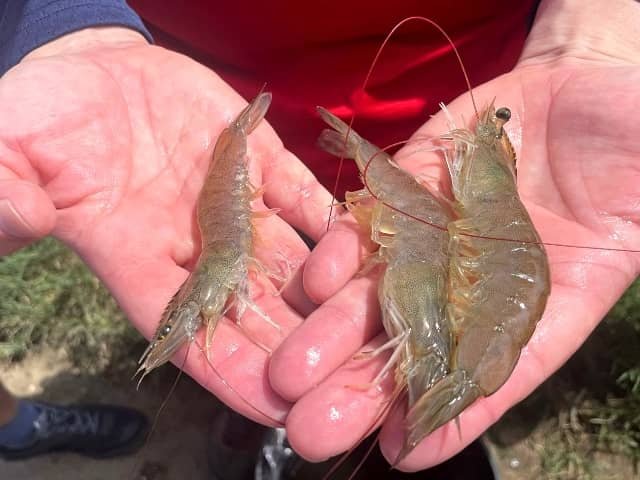
Shrimp are an important source of protein for human consumption, but their farming heavily relies on fishmeal, a resource that raises environmental concerns.
A study published by researchers from Shanghai Ocean University in the journal Aquaculture Nutrition explores the potential of Chlorella meal, a type of microalga, as a sustainable alternative protein source in the diet of Pacific white shrimp (Penaeus vannamei).
Why Algae? A Promising Solution
Fishmeal production raises environmental concerns, making sustainable alternatives essential. Microalgae, such as Chlorella, offer a promising solution. Chlorella is packed with nutrients, making it a potential protein source for farmed shrimp.
Previous research has shown success in partially replacing fishmeal with Chlorella for various fish and crustaceans, including Pacific white shrimp. These studies suggest that Chlorella can be a viable partial substitute without affecting growth, and with potential health benefits for the shrimp.
Earlier studies have reported successfully replacing 40% of fishmeal with Chlorella, but this study aimed to go further. The researchers studied the impact of replacing fishmeal with Chlorella while simultaneously adding cholesterol and essential amino acids to the diet. This approach aimed to optimize the nutritional profile of the shrimp.
Replacing Fishmeal with Chlorella: Impacts on Growth and Feed Efficiency
The researchers studied how replacing fishmeal with Chlorella meal affects Pacific white shrimp. They created diets with different levels of Chlorella, replacing fishmeal at 0%, 25%, 50%, 75%, and 100%. The shrimp were fed these diets for 56 days.
The good news: replacing up to 25% of fishmeal with Chlorella did not significantly impact the growth rate of the shrimp or their feed conversion efficiency. This suggests that Chlorella can partially replace fishmeal without compromising shrimp farming productivity.
However, replacing more than 50% of fishmeal resulted in decreased weight gain and lower protein and fat content in the shrimp. Additionally, the proportion of beneficial omega-3 and omega-6 fatty acids decreased.
Meat Quality and Other Considerations
Interestingly, replacing up to 75% of fishmeal did not negatively affect the overall texture or moisture content of the shrimp meat. However, the complete replacement of fishmeal resulted in shrimp with paler meat and lower levels of some essential amino acids.
Stay Always Informed
Join our communities to instantly receive the most important news, reports, and analysis from the aquaculture industry.
Furthermore, the researchers reported that higher inclusion of Chlorella increased the proportion of certain fatty acids (C18:2 and C18:3) compared to fishmeal diets.
Other factors such as digestive health, antioxidant levels, and muscle fiber density were not affected by the dietary changes.
Application in Shrimp Diets
These are the main findings of the study:
- Partial Replacement is Feasible: Up to 25% of fishmeal can be replaced with Chlorella meal without affecting shrimp growth or feed utilization. This is good news for sustainable shrimp farming as it reduces reliance on fishery resources.
- Essential Amino Acids and Cholesterol: Higher levels of Chlorella meal replacement (over 50%) negatively affected growth performance when not supplemented with essential amino acids (histidine, methionine) and cholesterol. These nutrients are crucial for optimal shrimp health.
- Digestibility May Influence: The cell walls of Chlorella may limit nutrient digestibility compared to fishmeal. Further research is needed to explore whether treatments can improve Chlorella digestibility for even higher inclusion levels.
- Meat Quality Maintained: Supplementing the diet with essential amino acids and cholesterol helped maintain good meat texture and water retention capacity even with Chlorella meal inclusion.
- Color Considerations: Complete fishmeal replacement led to decreased shrimp flesh color (yellowish and reddish). If maintaining specific color is important, additional dietary adjustments may be necessary.
- Nutritional Value Mostly Unaffected: The protein, lipid, and moisture content of shrimp flesh remained similar across all diets. However, some essential amino acid levels (lysine, methionine) decreased with high Chlorella meal inclusion.
- Flavor Not Compromised: The flavor of shrimp meat was not significantly affected by Chlorella meal in the diet.
Conclusion
This study demonstrates the potential of Chlorella meal as a partial substitute for fishmeal in shrimp diets. Replacing up to 25% of fishmeal with Chlorella appears to be a viable option that maintains shrimp growth and feed efficiency.
Further research is needed to optimize Chlorella-based diets and address the reduction of certain nutrients observed at higher replacement levels. However, these findings are a promising step towards a more sustainable future for shrimp aquaculture, reducing dependence on fishmeal and its environmental impact.
The study was funded by the National Key R&D Program of China.
Contact
Xiangjun Leng
National Demonstration Center for Experimental Fisheries Science Education, Shanghai Ocean University
Shanghai, China
Email: xjleng@shou.edu.cn
Reference (open access)
Li, M., Li, X., Yao, W., Wang, Y., Li, L., & Leng, X. (2024). Effects of Substituting Fish Meal by Chlorella Meal in Practical Diet on Growth, Feed Utilization, and Flesh Quality of Pacific White Shrimp (Penaeus vannamei). Aquaculture Nutrition, 2024(1), 9969518. https://doi.org/10.1155/2024/9969518
Editor at the digital magazine AquaHoy. He holds a degree in Aquaculture Biology from the National University of Santa (UNS) and a Master’s degree in Science and Innovation Management from the Polytechnic University of Valencia, with postgraduate diplomas in Business Innovation and Innovation Management. He possesses extensive experience in the aquaculture and fisheries sector, having led the Fisheries Innovation Unit of the National Program for Innovation in Fisheries and Aquaculture (PNIPA). He has served as a senior consultant in technology watch, an innovation project formulator and advisor, and a lecturer at UNS. He is a member of the Peruvian College of Biologists and was recognized by the World Aquaculture Society (WAS) in 2016 for his contribution to aquaculture.




